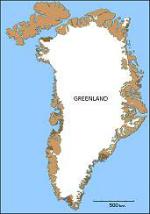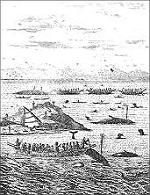
Thule
Thule culture chronology
The Thule culture is the latest phase of the prehistoric Inuit tradition. Developed around 1000 AD in North Alaska it spread eastwards along the Arctic shores of North America to Labrador and Greenland, which was reached approximately 1200 AD.
From the 15th century Thule culture sites were found throughout the eastern Arctic region. After that time, the culture was absent in the High Arctic and concentrated at lower latitudes. Recent migration from Canada into the Avanersuaq (Thule) area in northwestern Greenland began in the 18th century.
Geographical areas of the Thule culture

The The pioneering Inuit travelled throughout the length of Greenland's coast. No sites have been found in the northernmost part of the country except from a few shelters. From the Cape Farewell region, their winter dwellings are known along the west coast northwards to Washington Land, 80°N, and along the east coast to Amdrup Land, 81°N.
Thule culture sites are concentrated in the Avanersuaq (Thule) district, along the west coast between Upernavik and Cape Farewell, in Ammassalik and in the southern region of Northeast Greenland between Kong Oscar Fjord (71°N) and Clavering Island (74°N).
Social organisation of Thule culture

Relatively large settlements dating to the early occupational period tell about co-operation in whaling, especially in central West Greenland, the Avanersuaq (Thule) district and Northeast Greenland. On several sites, one larger structure has been interpreted as a qasse, or men's house. From the 17th century, long-distance travel activities in the southern half of the country are documented in both written and archaeological sources. From this period on, long-houses are the preferred dwelling for families among Greenlanders on whaling and trading expeditions including bartering with Europeans. Nuclear family dwellings became common in colonial Greenland from the mid 19th century and onwards. From a sociological point of view, the winter house and summer tent express the private and public spheres of Eskimo society, respectively.
Natural resources of Thule culture

Living and non-living resources were abundant and available for the Thule culture people. Different types of driftwood were used for house and tent construction, mostly along the west coast. Seal skins were used for covering these dwellings. Animal bones, antlers, tusks, teeth, driftwood and wood of local origin, as well as soapstone, were worked into hunting equipment, vessels, tools, household utensils, personal equipment and clothing.
Thule culture subsistence
Almost all terrestrial and marine animal species were subject to hunting. Sealing played a major role for local communities on an individual level, while whaling and caribou hunting took place as communal activities involving strategic co-operation. Fishing was an important supplement to subsistence and increased in South Greenland. The hunting of wintering birds on the ice-free waters of Southwest Greenland increased during the climate cooling period of the 17th and 18th century. Polar bears were hunted in northernmost West Greenland and on the east coast. Subsistence depended strongly on stores and meat caches to secure the communities from famine in late winter. Otherwise, former hunting grounds were left and new settlements established elsewhere. The depopulation of East Greenland in the 19th century was due to failure of subsistence economy.
Exchange and trade of Thule culture
External and internal contacts have always been part of the exchange economy of the Thule culture Inuit. The 13th century High Arctic pioneers seem to have had contacts with the Dorset people from whom they learned about the Cape York meteorites. Later contact with the Norse population supposedly occurred, but we have no evidence of bartering items, except for exotic objects found archaeologically in Inuit contexts. From the 17th century written sources mention Inuit trading expeditions along the European whaling grounds on the west coast of Greenland as well as intra-group exchange among Inuit offering special items. These included soapstone, caribou skin, baleen and driftwood. Inter-group marriage is known to have taken place, to secure kinship-based trading relationships.
Thule culture history of research
The Thule culture was defined in 1927 by Therkel Mathiassen on the basis of typological (topological) and functional similarities between the archaeological collections of the "Fifth Thule Expedition"'s Canadian material with other findings from North American Arctic and Siberia. From 1929 to 1934, Mathiassen conducted archaeology in West and Southeast Greenland, to describe Eskimo prehistory. The work was continued by Erik Holtved in the Avanersuaq (Thule) district in 1935-37 and 1946-47, in Northeast Greenland by Helge Larsen and P. V. Glob in 1931-33, and by J. Meldgaard and H.-G. Bandi in 1948. A comprehensive description of the Thule culture based on the above mentioned sources and excavations in West and East Greenland from in the 1970s, 80s and 90s was published by H. C. Gulløv in 1997.
In 2007-09, an International Polar Year programme will be carried out in Northeast Greenland focussing on the origin of the so-called Mixed Culture variant of the Thule culture.
References
Gulløv, Hans Christian (1997) From Middle Ages to Colonial Times. Archaeological and ethnohistorical studies of the Thule Culture in South West Greenland 1300 – 1800 AD. Meddelelser om Grønland, Vol. 23.
Gulløv, Hans Christian (ed.) (2004) Grønlands forhistorie (Prehistory of Greenland, in Danish). Gyldendal, Copenhagen (2nd impression, 2005).
Gulløv, Hans Christian (ed.) (2006) Kalaallit Nunaata Itsarsuaq Oqaluttuassartaa (Greenlandic version of Prehistory of Greenland). Ilinniusiorfik, Nuuk.